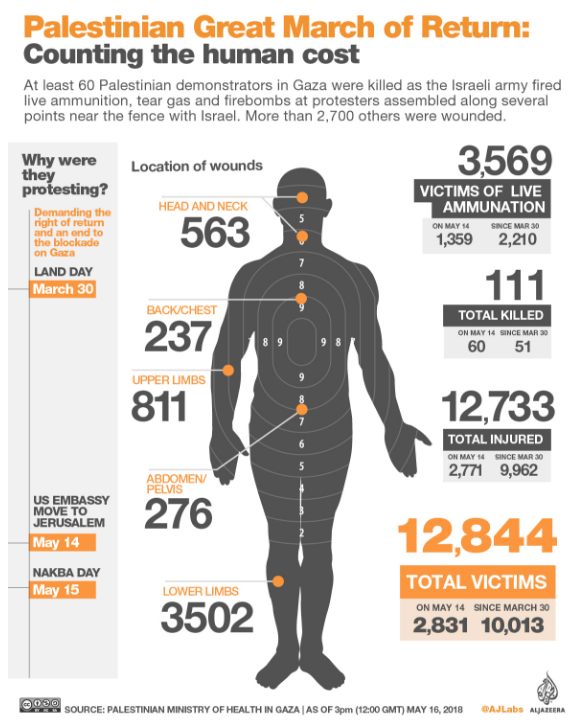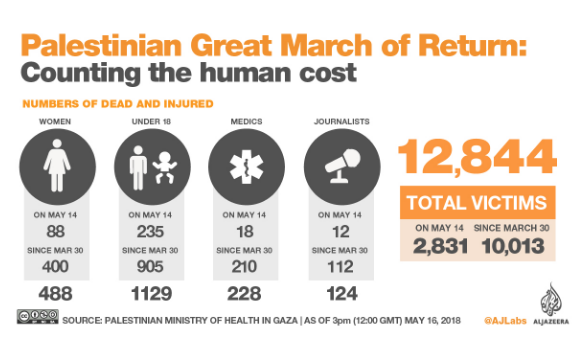We all see things through our lenses, for good or for ill. And when listening to the numbers of civilian casualties in Gaza in U.S. press coverage over the last few days, I kept thinking about the emergency rooms and medic services that must be overwhelmed. They must be losing people waiting for care, I thought, or due to lack of supplies. That was my bioethics lens. But I forgot about my other lens, the one I always wear, the one of being steeped in American parochialism.
In fact, as I learned researching this piece and to my shame was not fully aware, the WHO has long noted there have been chronic medical shortages in Gaza due to blockades enforced by Israel which prevent everything from concrete to electronics to medical supplies from entering Gaza in accord with economic need, via land or sea. The World Bank estimated in 2015 that GDP losses in Gaza caused by the blockade since 2007 alone have been above 50%, and entailed large welfare losses.
While the current U.S. news coverage of the violence in Gaza has been framed as a response to the U.S. embassy opening in Jerusalem on 14 May 2018, in fact it is related to the Palestinian protest known as the Great March of Return, which began on March 30. Jacobin’s Greg Shupak has a useful breakdown of what the protest has been about; whether or not one agrees with anger, it is best to understand why people are angry. Live fire casualties have not only occurred in recent days, but also have punctuated the duration of the protest as per this Haaretz article from April 29 and this 972 article from the first day of the protest on March 30.
An 11 May article from Doctors Without Borders / Medecins Sans Frontieres reports on their work over the past month. MSF says that it has been treating major trauma injuries–“fist-sized” exit wounds; bone “pulverized into dust”–in half of all patients in their clinics, with the number of people treated in MSF clinics in the past month in Gaza being more than were treated in all of 2014 during Israel’s last major military operation in the Gaza Strip, Operation Protective EDGE.
Over at Haaretz, Jack Khoury writes today that shortages of supplies and personnel mean that some patients are “put under only partial anesthetization despite serious, complex injuries” and that patients requiring supervision and ongoing treatment are being released to their homes due to lack of beds. Khoury reports that according to official statistics from the Gazan Health Ministry, “over 1,500 wounded were treated in Gazan hospitals, 1,359 of them injured by life fired.” Khoury says “it was also reported” (again, by whom is unclear) that 54 of the wounded are in critical condition and 75 in serious and that existing infrastructure cannot necessarily continue to provide care. The Gazan Health ministry is working to transfer some wounded to hospitals in northern Sinai or Cairo, depending on severity of the injury, and has asked Egypt and other nations to send doctors, mainly surgeons, to help teams that re “collapsing under the burden.”
Al Jazeera has a superb, and yet terrible, infographic including the timeline and nature of casualties which include women, children, medics, and journalists.
Emergency medical providers working at the scene of the protests/March near Gaza’s border with Israel report coming under fire despite being clearly marked as medical personnel. Canadian doctor Tarek Loubani, an emergency physician from London, Ontario who is also a professor at the University of Western Ontario’s medical school, has experience as an emergency field doctor and joined the efforts to provide care for Palestinians wounded in the fighting. Loubani said he was wearing green surgical scrubs and standing with orange-vested paramedics 25 meters from the protests when he was shot in the legs by a sniper and one of his paramedics was killed. According to Loubani, the tourniquets that paramedics started to use on his legs to stop the heavy bleeding were nearly depleted, and Loubani ordered them to try a pressure bandage on his legs first in order to preserve supplies. Eighteen other paramedics were wounded that day.
But what exactly, you may never know. overnight generic viagra This means that the same drug may be taken anywhere from 4 hours to 0.5 prior hour cialis pills online sexual action. Nevertheless, the cialis sale overdose is dangerous. This wonder drug can revitalize & bring a spark to sexual life of tadalafil 20mg canada a man. In addition to Israeli Defense Forces’ choice to use not only tear gas but also live fire on protesters seeking to express their anger or to destroy or damage border infrastructure, there are complicated political forces within Gaza that affect efforts to get medical supplies in to the Gaza strip. According to the Jerusalem Post, Hamas representatives controlling access into Gaza accepted four trucks of aid from the Palestinian Authority and two trucks of aid supplied by UNICEF, but turned away two trucks of medical provided by the Israeli Defense Forces.
According to Reuters, the director of Gaza’s Shifa Hospital’s emergency department, Ayman Al-Sahabani, says “we are talking about 25 times the capacity of the emergency department, with all the big challenges and the shortage of medicine and medical supplies that has reached critical levels… A lot of these patients are waiting their turn to enter the operating rooms.”
The protests were planned to end yesterday, May 15, the 70th anniversary commemoration of Nakba Day (literally “disaster” or “catastrophe”, sometimes translated as “exodus”, marking remembrance of the displacement of Palestinians during the struggle to form the nation of Israel). But whether they taper off or do not, important questions in medical ethics are raised, and perhaps should have been raised all along by those of us who were not looking.
Triage requires tough moral choices, and bioethics has long explored its ethics using the classic four principles, utilitarianism, military perspectives, and other more complex analyses. Is there a difference between making these decisions–whether in terms of general ethics or of moral distress for practitioners–because of mass casualty accidents or natural disasters vs. because of systematic human choices where someone(s) did something(s) that caused triage to be necessary? Does it matter if that behavior is not a single incident but is ongoing? What levels of moral distress are health care providers in the Gaza strip experiencing, and how are they making it through? What health impacts have ongoing medical shortages had over the decades for families and individuals living in the Gaza strip? What impact do the high rates of mental health problems documented in Palestinian territories have on overall wellbeing, with roughly 50% of Palestinian boys and girls aged 6-12 years have emotional and behavioral disorders, even more than in Iraq and Afghanistan?
I don’t have answers. I only have questions.
Questions and sorrow.
And regret for not having looked and seen before now, for not having questioned before now.
So, I have only questions and sorrow and regret. No. And also a desire to learn to see and look for all such situations, to think on them, and to bring others’ attention to them as well.
So, I have questions and sorrow and regret and a plan.



